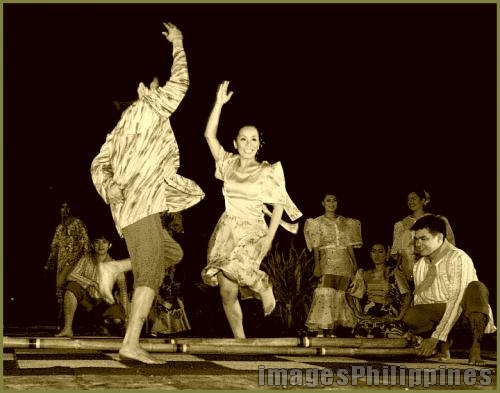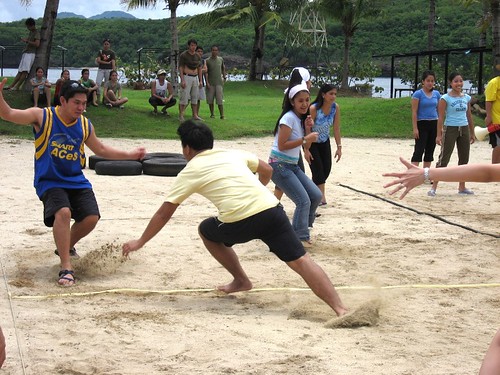About two-fifths of the
Religion in the
The
Arts of the Philippines
Literature
The literature of the Philippines illustrates the Prehistory and European colonial legacy of the Philippines Philippines
Performing Arts
Music
Spanish settlers and Filipinos played a variety of musical instruments, including flutes, guitar, ukelele, violin, trumpets and drums. They performed songs and dances to celebrate festive occasions
Fiesta
Dance
Philippine folk dances include the Tinikling and Carinosa. In the southern region of

Tinikling

Singkil Princess
Cuisine
Eating out is favorite Filipino pastime. A typical Pinoy diet consists at most of six meals a day; breakfast, snacks, lunch, snacks, dinner and again a midnight snack before going to sleep. Rice is a staple in filipino diet, it is usually eaten together with other dishes. Filipinos regularly use spoons together with forks and knives. Some also eat with their hands, especially in informal settings, and when eating seafood. Rice, corn, and popular dishes such as adobo (a meat stew made from either pork or chicken), lumpia (meat or vegetable rolls), pancit (noodle dish) and lechon(roasted pig) are served on plates.

Lechon
Other popular dishes include: afritada, asado, chorizo, empanadas, mani (roasted peanuts), paksiw (fish or pork, cooked in vinegar and water with some spices like garlic and pepper),pan de sal (bread rolls), pescado (fried or grilled fish), sisig, torta (omelette), kare-kare (ox-tail stew), kilawen, pinakbet (vegetable stew), pinapaitan, and sinigang (tamarind soup with a variety of pork, fish or prawns). Some delicacies eaten by some Filipinos but may seem unappetizing to the Western palate include balut (boiled egg with a fertilized duckling inside), longanisa (sweet sausage) and dinuguan (soup made from animal blood).

Balut
Popular snacks and desserts such as chicharon (deep fried pork or chicken skin), halo-halo(crushed ice with evaporated milk, flan, and sliced tropical fruits), puto (white rice cakes), bibingka (rice cake with butter or margarine and salted eggs), ensaymada (sweet roll with grated cheese on top), polvoron (powder candy) and tsokolate (chocolate) are usually eaten outside the three main meals. Popular Philippine beverages include San Miguel Beer, Tanduay Rhum Masters, lambanog and tuba.
Patis, suka, toyo, bagoong and banana catsup are the most common condiments found in Filipino homes and restaurants.
Sports in the Philippines
basketball, boxing, billiards, chess, ten-[in bowling, volleyball, horse racing and cock fighting. Doge ball and badminton are also popular.
Traditional Filipino games
Traditional Filipino games include yo-yo, piko, patintero, bahay kubo, pusoy and sungka. Pusoy is a popular gambling game. Individuals play the game by trying to get rid of all the cards by choosing poker hands wisely. Sungka is played on a board game using small sea shells in which players try to take all shells. The winner is determined by who has the most shells at the point when all small pits become empty.

Filipinos playing Patintero